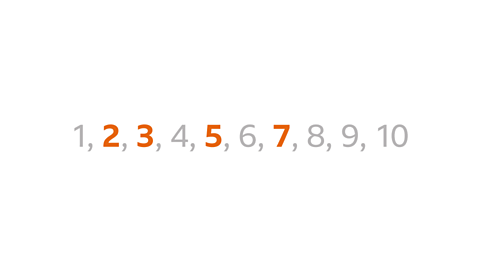Key points
A factorA whole number that will divide into a selected number with no remainder. is an integerIntegers are numbers with no fraction or decimal part. They can be positive, negative or zero. 42, 8, and 10000 are examples of integers.that divides exactly into a whole number without a remainder. Eg, 3 is a factor of 12
A factor pairTwo numbers that, when multiplied together, make a selected whole number. Eg, 3 and 4 are multiplied together to make 12 so 3 and 4 are a factor pair of 12. A whole number may have one or more factor pairs. is a set of two factors. When multiplied together, they give a particular productThe result of multiplying one number by another, eg the product of 4 and 5 is 20 since 4 × 5 = 20. Eg, 3 and 4 have a product of 12, so 3 and 4 are a factor pair of 12
A multipleAn integer that is in the multiplication table of a specific number. Eg, 20 is a multiple of ten because 20 is in the ten times table. is a number that is in a particular times table. Eg, 12 is a multiple of 3 because 12 is in the 3 times table. 12 is also a multiple of 4 because 12 is also in the 4 times table.
Knowing multiplication and division facts supports understanding of factors and factor pairs. Knowing divisibility rulesRecognising when a number can be divided exactly by a selected integer. Eg, any even number is divisible by 2 is helpful in identifying multiples of a particular number.
What is a factor?
- A factorA whole number that will divide into a selected number with no remainder. is an integer that divides exactly into a selected whole number with no remainder.
- Every whole number greater than 1 has two or more factors.
- When a number is divided by one factor, the answer is another factor. The two factors are called a factor pairTwo numbers that, when multiplied together, make a selected whole number. Eg, 3 and 4 are multiplied together to make 12 so 3 and 4 are a factor pair of 12. A whole number may have one or more factor pairs..
- The productThe result of multiplying one number by another, eg the product of 4 and 5 is 20 since 4 × 5 = 20 of each factor pair is equal to the number.
Remember: The first factor pair is always 1 and the number itself.
Example: factors and factor pairs
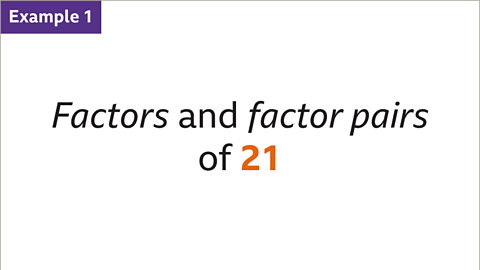
Image caption, What are the factors and factor pairs of 21?
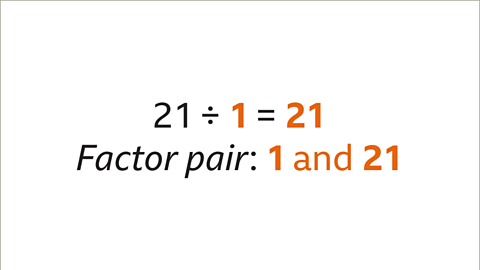
Image caption, 21 can be divided by 1 with no remainder. 1 is a factor of 21. The answer 21 is also a factor of 21. 1 and 21 are a factor pair of 21
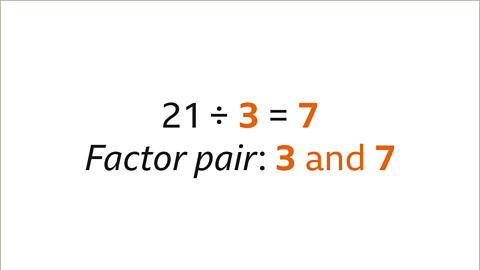
Image caption, 21 can be divided by 3 with no remainder. 3 is a factor of 21. The answer 7 is also a factor of 21. 3 and 7 are a factor pair of 21
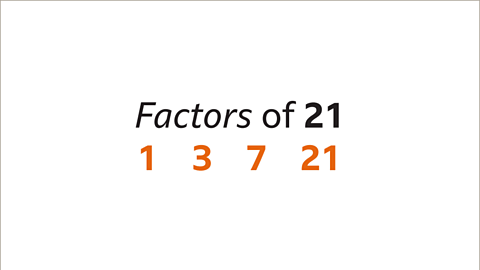
Image caption, 21 has 4 factors. They are: 1, 3, 7 and 21
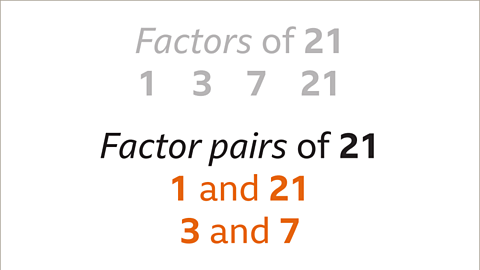
Image caption, The factor pairs of 21 are 1 and 21, 3 and 7
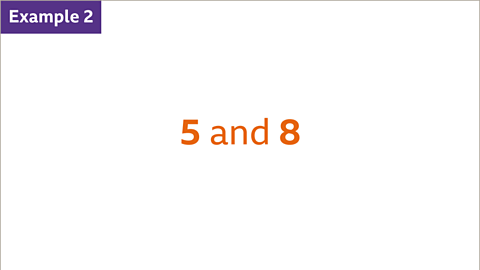
Image caption, The product of each factor pair is equal to the number. Which number is 5 and 8 a factor pair for?
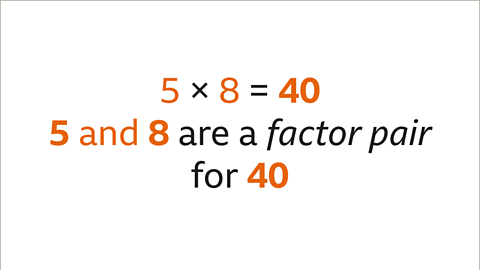
Image caption, The product of 5 and 8 (5 x 8) is 40. 5 and 8 are a factor pair for 40
1 of 7
Question
Which of these numbers are factors of 6?
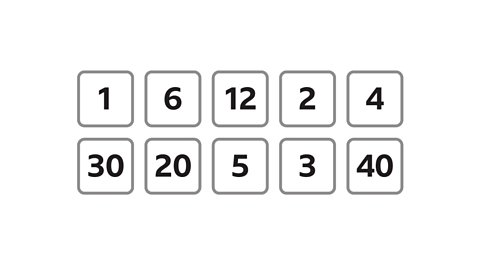
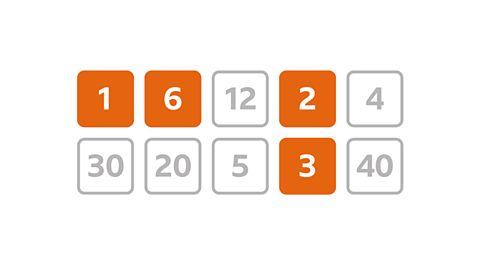
The factors of 6 divide exactly into 6
The factors of 6 are 1, 6, 2 and 3
How to find all the factor pairs of a number
When finding all the factor pairTwo numbers that, when multiplied together, make a selected whole number. Eg, 3 and 4 are multiplied together to make 12 so 3 and 4 are a factor pair of 12. A whole number may have one or more factor pairs. of a number, there is a methodical approach you can take:
- Remember that the first factor pair is always 1 and the number itself.
- Consider whether the number is divisible, in turn, by 2, 3, 4 etc. Use your understanding of the divisibility rulesRecognising when a number can be divided exactly by a selected integer. Eg, any even number is divisible by 2 and times tables up to 12 x 12 to help.
- When a number is divided by one factor, the answer is another factor. The two factors are called a factor pair.
- The productThe result of multiplying one number by another, eg the product of 4 and 5 is 20 since 4 × 5 = 20 of each factor pair is equal to the number.
Remember: all the factors are found when the next value is part of an established factor pair.
Example: factor pairs of 30
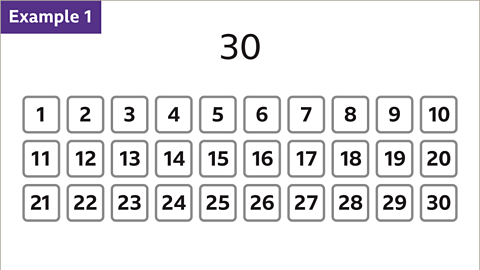
Image caption, Find all the factors and factor pairs of 30
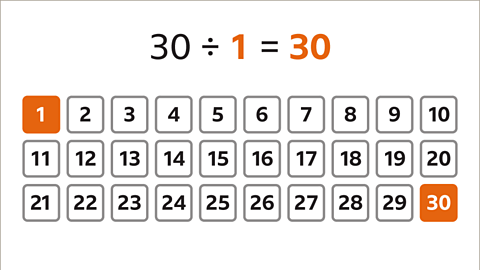
Image caption, Start with 1. 30 ÷ 1 is 30. The first factor pair is 1 and 30
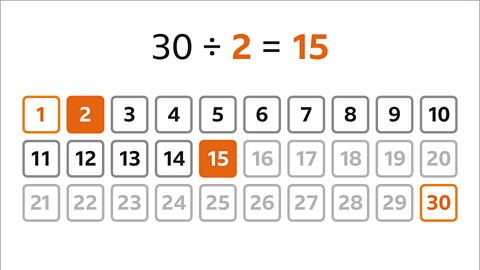
Image caption, The next number in the list to try is 2. 30 ÷ 2 is 15. The next factor pair is 2 and 15
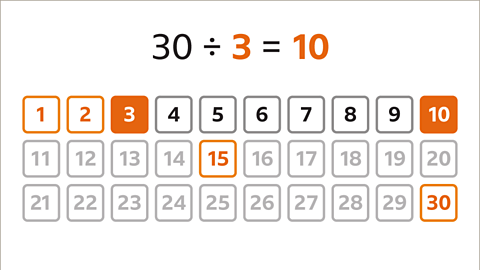
Image caption, The next number in the list to try is 3. 30 ÷3 is 10. The factor pair is 3 and 10
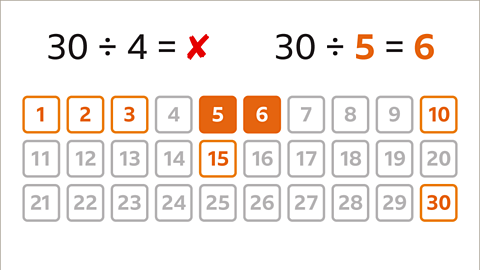
Image caption, The next number in the list to try is 4. 4 does not divide exactly into 30. Try the next number in the list (5). 30 ÷ 5 is 6. The next factor pair is 5 and 6. This is the final factor pair because the next number (6) is already part of an established factor pair.
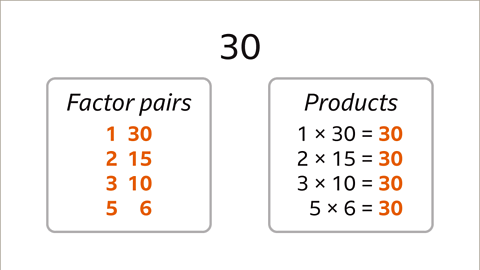
Image caption, The factor pairs of 30 are: 1 and 30, 2 and 15, 3 and 10, 5 and 6. Each factor pair has a product of 30
1 of 6
Question
Find all the factor pairs of 28

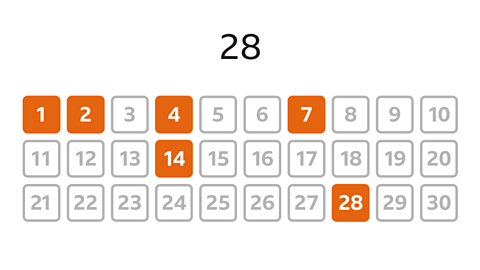
The factor pairs of 28 are:
- 1 and 28
- 2 and 14
- 4 and 7
Each factor pair has a product of 28
What is a multiple?
- A multipleAn integer that is in the multiplication table of a specific number. Eg, 20 is a multiple of ten because 20 is in the ten times table. is a whole number in the times table of a selected whole number.
Eg, any number in the 4 times table is a multiple of 4. Multiples of 4 include 4, 8, 12, 16, 20 … - There are an infiniteUnlimited, endless number of multiples for any whole number.
Example: multiples of 5
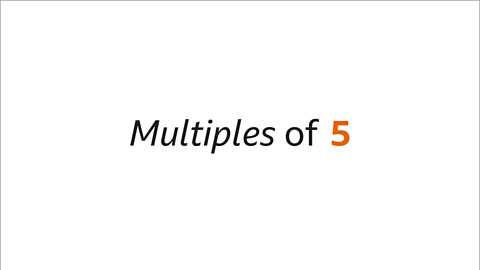
Image caption, What are the multiples of 5?
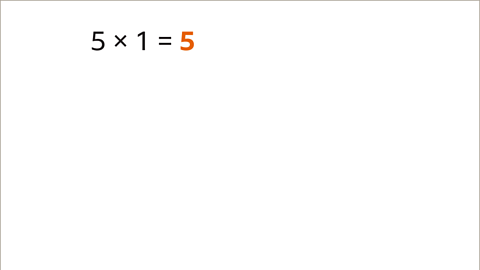
Image caption, The 5 times table generates multiples of 5. 5 x 1 = 5. The first multiple of 5 is 5
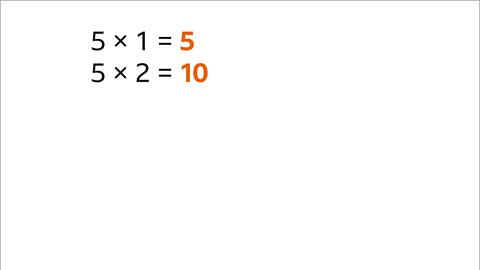
Image caption, 5 x 2 = 10. The second multiple of 5 is 10
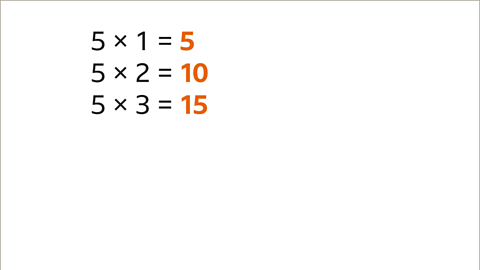
Image caption, 5 x 3 = 15. The third multiple of 5 is 15
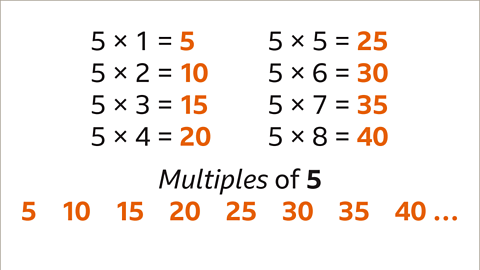
Image caption, This list continues forever. There are an infinite number of multiples of 5
1 of 5
Question
Which of these numbers are multiples of 6?
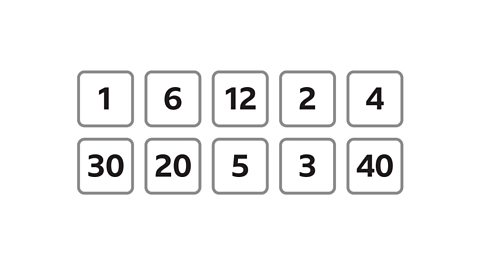
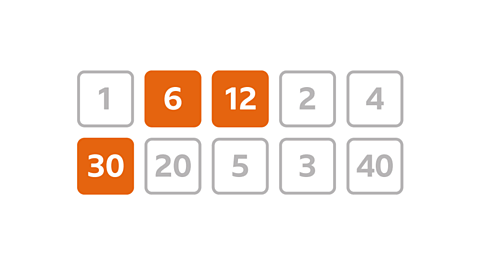
Any number in the 6 times table is a multiple of 6
The numbers in the list that are multiples of 6 are:
- 6 (6 x 1 = 6)
- 12 (6 x 2 = 12)
- 30 (6 x 5 = 30)
Practise factors and multiples
Try this quiz to practise finding factors, factor pairs and multiples.
Quiz
Real-world maths
Factors
Factors are used every day when we divide or share something into equal pieces. Eg, an outdoor adventure company who organises group activities may need to split a large group of people into smaller groups for each activity.

A group of 24 people could be split into:
- 6 groups of 4 (6 x 4 = 24)
- 8 groups of 3 (8 x 3 = 24)
- 12 pairs (12 x 2 = 24)
Different activities may need different sized groups. As 24 has several factor pairs, organising the activities is easier than if there were 25 people.
Multiples
A baker will bake in batches to minimise food waste. Eg, if cupcakes are packed in boxes of 6, the batches baked will be a multiple of 6. A small batch may be for 24 cupcakes, a large batch bake could be for 120 cupcakes.

Game - Divided Islands
Play the Divided Islands game! gamePlay the Divided Islands game!
Using your maths skills, help to build bridges and bring light back to the islands in this free game from BBC Bitesize.

More on Prime numbers, factors and multiples
Find out more by working through a topic
- count2 of 4

- count3 of 4
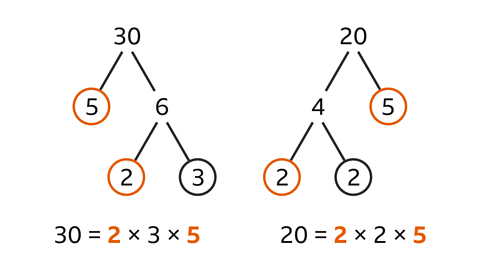
- count4 of 4
